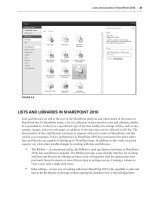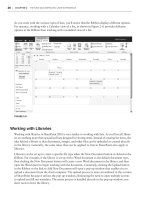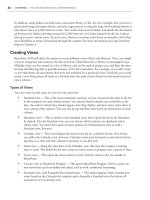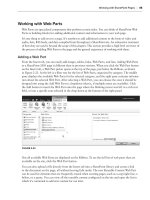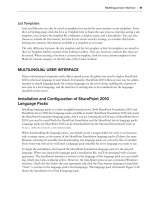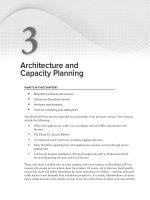Thủ thuật Sharepoint 2010 part 87 pps
Bạn đang xem bản rút gọn của tài liệu. Xem và tải ngay bản đầy đủ của tài liệu tại đây (637.21 KB, 9 trang )
Working with SharePoint
Designer 2010
WHAT’S IN THIS CHAPTER?
Introduction to SharePoint Designer
The new user experience
Controlling the use of SharePoint Designer
Uses of SharePoint Designer
Organizations purchase SharePoint to help them do more with less. SharePoint is a tool to help
companies work smarter as opposed to harder. Although SharePoint is very powerful and has
a long list of features and capabilities out of the box, it is fair to assume that most companies
are going to want to customize the product in some way. This is where SharePoint Designer
(SPD) fi ts into the picture; it is the preferred tool for customizing SharePoint.
Before we get too far into this chapter, we need to address the elephant in the room. Whether
you are a developer or an administrator, you’ve probably already formed an opinion about
SharePoint Designer or have heard co-workers and friends saying negative things. This book
is family friendly and many of the comments about SPD shouldn’t be repeated — let’s just say
that most folks seem to think that the tool does more harm than good.
The bad reputation started back with Microsoft FrontPage, a product that made creating
websites easy, almost too easy in many cases. Bad websites created using FrontPage began
to pop up all over the place. FrontPage’s reputation was so toxic that there are tales of
web developers not being hired because they listed FrontPage on their resumes.
However, aside from making bad websites, FrontPage was also the tool of choice for customizing
SharePoint 2003. It wasn’t until organizations started upgrading to SharePoint 2007 that everyone
realized the full extent of the problems that were caused by FrontPage. Entire migration efforts were
made signifi cantly more diffi cult because of how FrontPage customized SharePoint sites.
22
648
CHAPTER 22 WorkiNg With sharePoiNt desigNer 2010
When SharePoint 2007 was released, FrontPage was split into two products: Microsoft Office SharePoint
Designer 2007 and Expression Web Designer. The name FrontPage was conspicuously dropped from both
products. SPD 2007 was a vast improvement over FrontPage. The tool was designed to be the primary
way to customize SharePoint 2007, and it enabled users to not only change the user interface but also to
build powerful applications without writing any code. This meant that any business user was able to use
SPD 2007 to create functionality, such as a custom workflow, that previously required a developer and
significant effort to accomplish.
Despite the name change and all of the new functionality in SPD 2007, the negative perceptions
persisted. Many users described their “love-hate” relationship with the product. The common feel-
ing was that although SPD 2007 was one of the most powerful software tools they had ever used to
create valuable business solutions with SharePoint, it was also very quirky. For example, SPD 2007
enabled users to back up a site as long as the site was not larger than 24MB. In other cases, users
would get frustrated with SPD 2007 because it would rewrite the code for their web page without
asking. Additionally, SharePoint administrators were frustrated by SPD 2007 because of the lack of
control they had over the tool being used in their environment.
Yes, FrontPage and SPD 2007 both had some issues; but all of these things are behind us now.
When SharePoint Designer 2010 was created, it was done so with many of these complaints and
pain points in mind. Therefore, for those of you who have written off SPD and called it nasty
names, it’s time to give the tool another chance. The whole product has been revamped to place
more of an emphasis on integrating with SharePoint and less on being a tool for editing web
pages that also kind of has something to do with SharePoint.
This chapter provides a high-level overview of the features and capabilities of SharePoint Designer 2010.
You’ll take a look through the various menus and see some examples of how to perform several common
tasks, including the following:
Managing your sites
Working with data sources
Views and forms
Workflows
Branding
Sit back, relax, and take a deep breath as we venture off on a tour of SharePoint Designer 2010.
WHO SHOULD USE SHAREPOINT DESIGNER?
SPD is a very powerful tool, and despite many of the improvements for SPD 2010 that simplify its use,
in the wrong hands it can cause problems. Whether you are a SharePoint administrator, developer, or
end user, make sure that when you first start using SPD you are doing so from a place where you can
do no harm.
With that public service message out of the way, who should use SPD? The tool is intended to be
used by site owners and power users to create and add functionality to SharePoint, without needing
to know how to write code. The same reasons that make SPD an ideal tool for end users also make
it an ideal tool for developers and administrators.
Introduction to SharePoint Designer 2010
649
INTRODUCTION TO SHAREPOINT DESIGNER 2010
The name “SharePoint Designer” suggests that it is a tool for website designers, but customizing your
site’s look and feel is just one of many tasks that SPD is capable of doing. Perhaps a better name would
be something like “SharePoint Management Studio” because SPD 2010 acts as a central location to
manage your SharePoint sites.
There have been a number of improvements to SPD 2010, starting with a new UI. Like everything
else in SharePoint 2010, SPD has been updated with a new user interface that introduces the fl uent
UI, otherwise known as “The Ribbon.” By now this isn’t a new concept. Aside from the Ribbon, the
menus themselves have been updated to make it easier to do many common tasks. Those familiar
with SPD 2007 would often use the tool to make changes to web pages or create a custom workfl ow.
With SPD 2010, most of the functionality from the previous version is still there (and improved), but
it is now possible to manage your SharePoint sites directly from the tool. In this section we’ll discuss
the basics you’ll need to begin using SharePoint Designer 2010.
Requirements for Using SPD 2010
On April 2, 2009, Microsoft announced that SharePoint Designer 2007 would be available as a
free download. Many assumed that this was an April Fool’s Day joke that came a day too late, but
it was no joke. Microsoft made this move because several organizations decided not to purchase
the tool based on its original cost. When SPD 2010 was announced, many wondered if the tool
would still be offered as a free product. The good news is that SPD 2010 will indeed be available
as a free download, at
www.microsoft.com/spd. Following are the necessary requirements:
Supported operating systems
— Windows 7; Windows Server 2003; Windows Server 2003
Service Pack 1; Windows Server 2003 Service Pack 2; Windows Server 2008 R2; Windows
Server 2008 Service Pack 2; Windows Vista Service Pack 1
Computer and processor
— 500 MHz processor or higher
Memory
— 256 megabytes (MB) of RAM or higher
Hard disk
— 2.5GB minimum
SharePoint Designer 2010 works only with SharePoint 2010. If you try to open
your MOSS sites with SPD 2010, it won’t work. Although this might be frustrating
for some users, it was a decision made by the SharePoint Designer product team
in order to make it possible to implement all of the changes for the new version of
the project.
In environments where SharePoint 2007 and SharePoint 2010 are both installed,
it might be necessary to have SPD 2007 and SPD 2010 installed side by side on
the same machine. If this applies to you, make sure you install the same version
of SPD 2010 that you did with SPD 2007. Because SPD 2007 only came in x86,
if you wanted to install SPD 2010 on the same machine it would be necessary to
install SPD 2010 x86.
650
CHAPTER 22 WorkiNg With sharePoiNt desigNer 2010
OVERVIEW OF THE NEW UX
It should be pretty obvious by looking at SharePoint Designer 2010 that there have been some signifi-
cant improvements to the user interface. Aside from the Ribbon, the entire user experience for SPD
2010 now reflects the stronger focus on SharePoint itself. Users can now easily see all the components
that make up their sites, and the various relationships between the components. In general, users can
now control most of the common pieces of their SharePoint site directly from SPD 2010 without having
to wade through several disconnected settings screens.
Before we proceed, it would probably be helpful to actually open SharePoint Designer so that
it is easier to follow along: Click StartAll ProgramsSharePoint, and then click Microsoft
SharePoint Designer 2010.
The first screen that opens is referred to as the Sites place. This screen is divided into four self-
explanatory areas: Open SharePoint Site, New SharePoint Site, Recent Sites, and Site Templates.
In the Site Templates section, by default you’ll only see three options for templates: Blank Site, Blog,
and Team Site (see Figure 22-1). Clicking on one of these templates will open up a dialog that enables
you to create a new site once you specify a URL. If you want to create a new site based on a different
template that isn’t specified, you can click the More Templates button and type in the URL of a site
that has more options. For example, typing in the URL for a site created using the Enterprise Wiki
template would allow you to choose from additional templates such as Enterprise Wiki, Publishing
Site, and so on.
FIGURE 221
If this is the first time you’ve opened SharePoint Designer, the Recent Sites area will be blank and
you’ll need to click the Open Site button. Once the Open Site dialog opens, you can type in the address
of your site in the format of
http://contoso or http://contoso/subsite and then click Open.
Your site will open to what is referred to as the settings page, shown in Figure 22-3, which displays
high-level information such as the title, description, URL, SharePoint version number, permissions,
subsites, etc. The settings page for the site is the starting point from which all changes to your site
Overview of the New UX
651
can be made. Previously, when SPD 2007 opened, users were presented with a multi-paned interface
that contained a blank HTML page and other areas that allowed you to edit the parts of your page
(see Figure 22-4). SPD 2010 has an updated user interface that puts more of a focus on SharePoint
itself. All aspects of your SharePoint site should be easily accessed from this page.
In SharePoint Designer 2007 it was possible to do offl ine editing of fi les such as
master pages or page layouts. With SPD 2010, it is still possible to do offl ine edit-
ing but you must fi rst connect to a SharePoint site. In other words, if you don’t
have access to a SharePoint site, you won’t be able to use SPD even if someone
were to send you the fi le. If you do try to edit a fi le without fi rst opening a site,
you’ll get the error shown in Figure 22-2.
FIGURE 222
FIGURE 223
652
CHAPTER 22 WorkiNg With sharePoiNt desigNer 2010
The user interface, shown in Figure 22-5, is
divided into three main areas:
Navigation
— This pane shows the
various components that make up a site,
including lists, libraries, master pages,
page layouts, workflows, content types,
etc. Clicking on one of the links will take
you to a Gallery page.
Gallery and Summary
— This is the main
area of the screen, which displays the lists
of each component type along with sum-
mary information.
Ribbon
— As with the rest of SharePoint,
electing an object causes the Ribbon to
display menus and options for customizing
that object.
The navigation panel is the most common way to navigate the site. No matter which gallery has
been clicked, the navigation panel is always visible. You can quickly jump to the settings page by
clicking the Site link (listed first in the navigation) or jump to any of the other areas of the site.
FIGURE 225
FIGURE 224
Overview of the New UX
653
The gallery pages provide a high level view of each of the various areas of the site. Whether you
are trying to determine how many lists there are or what workflows are available, the galleries
provide a quick way to get whatever information you need about the site. Additionally, clicking
on a gallery will cause the Ribbon to change context and show buttons related to what’s selected.
For example, if you are on the site settings page, then the Ribbon displays common actions
you might perform at the site level; but if you click the Lists and Libraries gallery, the Ribbon
changes to show options specifically related to lists and libraries. In
most cases, the options available in SPD are the exact same options
that are available from the SharePoint user interface. The advantage
of SPD is that it provides a single place to quickly navigate through
the different areas of the site.
Another thing to note is that a gallery can be opened as a “mini-gallery”
below the navigation pane. To do this, hover your mouse over the link
for a gallery in the navigation and you’ll see a pin icon (see Figure 22-6).
Clicking the pin icon displays the mini-gallery. This mini-gallery will
continue to show even when you select a different gallery. However, it is
only possible to pin one gallery at a time.
Once you click the link in the navigation, the contents of the gallery will
be displayed. In most of the galleries, clicking the name of an item once
will open its settings page, but double-clicking on the item will open its
editor. For example, if you click the Lists and Libraries gallery and then
click the title for the Announcements list, the settings page will open;
but if you were to instead double-click on the list, the editor will open
for the list, showing the various columns along with new options avail-
able from the Ribbon.
Opening the editor for an object can be tricky, though. The easi-
est way is to ensure that you double-click away from the name of
the object you are clicking on. For the Announcements list, it might
be easier to click on the item near the Type column, rather than the
Name column.
Bread Crumbs, Tabs, and Navigation
The way that you navigate throughout SPD 2010 has also changed significantly. As mentioned pre-
viously, the site settings page is now the common area that can be used to access all other areas of
the site; but as you navigate from the site settings page, there are now additional ways that make it
easier to get around. Users who are familiar with Windows 7 will find the navigation aspects of SPD
2010 to be very familiar.
There are forward and back buttons that function the same as if you were navigating around in
your favorite web browser. If you click on an area of the site and want to go back to the place you
just were, simply click the back button to return to the page. Additionally, if you’ve got forward and
back buttons on your mouse they can also be used in the same way that they work with Web pages
in a browser.
FIGURE 226
654
CHAPTER 22 WorkiNg With sharePoiNt desigNer 2010
There is also a bread crumb navigation that shows where you are in relation to the site. For example,
if you were to click on Lists and Libraries and then the Announcements list, the bread crumb would
have a link for each level if you wanted to jump up in the site hierarchy (see Figure 22-7). The bread
crumb links themselves can be expanded, enabling you to quickly jump to other areas of the site.
As you click on different files, they will open as different tabs in your site. This works very similarly
to how tabs work in a web browser. Each tab maintains a history, so it is easy to quickly jump back to
something you were working with earlier (see Figure 22-8).
FIGURE 227
FIGURE 228
The File Tab
Most of us are used to the concept of a File menu that can be accessed in the upper-left corner of all
software applications. SPD 2010 is no different; a quick glance in the upper-left corner of the screen
shows the File tab, which is highlighted in orange so it is tough to miss. Clicking the File link will
take you to a page that looks very similar to the one you first see when you start SPD 2010. This
menu is the place for doing things above and beyond working on the site you might be editing. The
File tab is the location from which you can open other sites, add pages, import files, or view and
change SPD 2010’s settings. If you need the Help menus or want to find the version number for SPD
2010, that would also be accessed from this menu. To exit out of this screen, click the tab to the
immediate right of the File tab to go back to where you were.
Checking and Changing the Current User
You may have noticed a small icon in the bottom left corner of your SPD 2010
window that looks like a person (see Figure 22-9). If you hover your mouse over
this icon, it will highlight the name of the user currently logged in to SPD 2010.
Clicking this icon enables you to log in with a different user account. This is use-
ful for testing permissions scenarios or support issues to determine what access a
specific user might have.
FIGURE 229
Restricting Access to SharePoint Designer
655
RESTRICTING ACCESS TO SHAREPOINT DESIGNER
Early in the chapter we mentioned the negative feelings that many users have had about previ-
ous versions of SPD. These feelings weren’t just isolated to individuals; many organizations also
decided not to use SPD. Despite the fact that SPD 2007 was a very powerful tool, one of its major
shortcomings was that it was very difficult to control access. If you had enough access to a site,
then you could use SPD. This problem was magnified when the tool was made available as a free
download. Organizations wrote lengthy governance documents that outlined how SPD was to be
used in their environment, but unfortunately those words didn’t actually stop brave users from
downloading the tool and doing things they shouldn’t be doing.
SharePoint administrators everywhere can breathe a sigh of relief, because SharePoint 2010 now pro-
vides much tighter control over how SPD can be used in an organization with the following settings:
Enable SharePoint Designer
— Determines whether SharePoint Designer can be used at all.
Enable Detaching Pages from the Site Definition
— Allows edited pages to be customized,
which detaches them from the site definition.
Enable Customizing Master Pages and Layout Pages
— Removes the Master Page link from
the navigation pane and prevents users from updating master pages and layout pages.
Enable Managing of the Web Site URL Structure
— Removes the All Files link from the navi-
gation pane.
These new options enable organizations to control SPD 2010 at the level appropriate to their
requirements. SharePoint 2010 allows access to SPD to be controlled at two different levels:
Central Administration
— Accessed from the General Application Settings menu, this enables
farm administrators to control SPD at the web application level. Disabling the options here
prevents site collection administrators from enabling the functionality.
Site Collection
— Accessed from the Site Collection Administration section in Site Settings,
this enables site collection administrators to control SPD access for Designers and Site
Owners.
The following example walks you through the process of updating the SPD settings from Central
Administration:
1. Open Central Administration from your SharePoint server by clicking StartAll
ProgramsMicrosoft SharePoint 2010 ProductsMicrosoft SharePoint 2010 Central
Administration.
2. Click General Application Settings in the left navigation.
3. From the SharePoint Designer section, click Configure SharePoint Designer settings (see
Figure 22-10).



